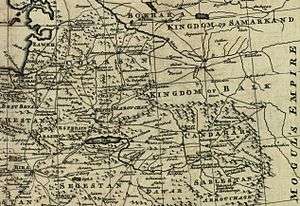Abdul Aziz Hotak
| Abdul Aziz Hotak | |||||
|---|---|---|---|---|---|
| Emir of Greater Kandahar | |||||
| Reign | Hotak Empire: 1715–1717 | ||||
| Coronation | 1715 | ||||
| Predecessor | Mirwais Hotak | ||||
| Successor | Mahmud Hotak | ||||
| Died |
1717 Kandahar | ||||
| |||||
| Dynasty | Hotak dynasty | ||||
| Father | Salim Khan | ||||
| Mother | Nazo Tokhi | ||||
| Religion | Sunni Islam | ||||
Shāh Abdul Azīz Hotak (died 1717) (Pashto: عبد العزیز هوتک) was the second ruler of the Ghilji Hotak dynasty of Kandahar, in what is now the modern state of Afghanistan. He was crowned in 1715 after the death of his brother, Mirwais Hotak. He is the father of Ashraf Hotak, the fourth ruler of the Hotak dynasty. Abdul Aziz was killed in 1717 by his nephew Mahmud Hotak.
Early life
Abdul Aziz was born in a well known, rich and political family in the Kandahar area. His family was involved in social and community services since long ago. He was the son of Salim Khan and Nazo Tokhi (also known as "Nazo Anaa"), grandson of Karum Khan and great grandson of Ismail Khan, a descendant of Malikyar, the ancient head of Hottaki or Hotaks. The Hottaki is a strong branch of Ghilji, one of the main tribes among the Pashtun people. Hajji Amanullah Hottak reports in his book that the Ghilji tribe is the original residents of Ghor or Gherj. This tribe migrated later to obtain lands in southeastern Afghanistan and multiplied in these areas.[1]

In 1707, Kandahar was in a state of chaos due to it being fought for control by the Shi'a Persian Safavids and the Sunni Moghuls of India. Mirwais Khan, a Sunni tribal chief whose influence with his fellow-countrymen made him an object of suspicion, was held as a political prisoner by the Safavid governor over the region, Gurgin Khan, and sent to the Safavids court at Isfahan. He was later released and even allowed to meet with the Shah, Sultan Husayn, on a regular bases. Having sown this seed of false trust and having completely ingratiated himself with the Persian Court, Mirwais sought and obtained permission to perform the pilgrimage to Mecca in Ottoman empire. He had studied carefully all the military weaknesses of the by then heavily declined Safavids while he spent time there in their court.[2][3]
It was in 1709 when Mirwais and Abdul Aziz began organizing his countrymen for a major uprising, and when a large part of the Persian garrison was on an expedition outside the city, followers of Mirwais and Abdul Aziz fell on the remainder and killed the greater number of them, including Gurgin Khan.[3]
The Pashtun tribes rankled under the ruling Safavids because of their continued attempts to forcefully convert them from Sunni to Shia Islam.[2] After Gurgin Khan and his escort were killed during a picnic in April 1709, the Hotak tribe took control of the city and the province.[4] The Pashtun rebels then defeated a large Qizilbash and Persian army, sent to gain control over the area.
Several half-hearted attempts to subdue the rebellious city having failed, the Persian Government despatched Khusraw Khán, nephew of the late Gurgín Khán, with an army of 30,000 men to effect its subjugation, but in spite of an initial success, which led the Afgháns to offer to surrender on terms, his uncompromising attitude impelled them to make a fresh desperate effort, resulting in the complete defeat of the Persian army (of whom only some 700 escaped) and the death of their general. Two years later, in. 1713, another Persian army commanded by Rustam Khán was also defeated by the rebels, who thus secured possession of the whole province of Qandahár.[3]— Edward G. Browne, 1924
Death
Abdul Aziz wanted to make a peace treaty with the Persians but his country men were opposed to this idea so they forced Mahmud Hotak to murder him in 1717. In the same year he got succeeded by Mahmud Hotak.
Abdul Aziz is buried at a mausoleum next to his brother in the Kokaran section of Kandahar City in Afghanistan.[5]
See also
References
- ↑ http://www.beepworld.de/members4/wolas/mirwaisneeka.htm
- 1 2 Ewans, Martin; Sir Martin Ewans (2002). Afghanistan: a short history of its people and politics. New York: Perennial. p. 30. ISBN 978-0-06-050508-0. Retrieved 2010-09-27.
- 1 2 3 "AN OUTLINE OF THE HISTORY OF PERSIA DURING THE LAST TWO CENTURIES (A.D. 1722–1922)". Edward Granville Browne. London: Packard Humanities Institute. p. 29. Retrieved 2010-10-01.
- ↑ Otfinoski, Steven (2004). Afghanistan. Infobase Publishing. p. 8. ISBN 978-0-8160-5056-7. Retrieved 2010-09-27.
- ↑ "Mir Wais Hotak (1709–1715)". Nancy Hatch Dupree. Archived from the original on 5 November 2010. Retrieved 2010-10-01.
External links
| Preceded by Mirwais Hotak |
Emir of Afghanistan 1715–1717 |
Succeeded by Mahmud Hotak |